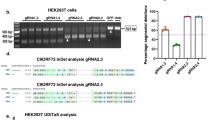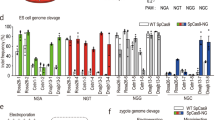Abstract
The Friedreich ataxia is a monogenic disease due to a hyperexpanded GAA triplet located within the first intron of the frataxin gene that causes transcriptional issues. The resulting frataxin protein deficiency leads to a Fe-S cluster biosynthesis dysfunction in the mitochondria and to oxidative stress and cell death. Here we use the CRISPR-Cas9 system to remove the mutated GAA expansion and restore the frataxin gene transcriptional activity and protein level. Both YG8R and YG8sR mouse models and cell lines derived from these mice were used to CRISPR-edited successfully the GAA expansion in vitro and in vivo. Nevertheless, our results suggest the YG8sR as a better and more suitable model for the study of the CRISPR-Cas9 edition of the mutated frataxin gene.
This is a preview of subscription content, access via your institution
Access options
Subscribe to this journal
Receive 12 print issues and online access
$259.00 per year
only $21.58 per issue
Buy this article
- Purchase on Springer Link
- Instant access to full article PDF
Prices may be subject to local taxes which are calculated during checkout







Similar content being viewed by others
References
Babady NE, Carelle N, Wells RD, Rouault TA, Hirano M, Lynch DR et al. Advancements in the pathophysiology of Friedreich's Ataxia and new prospects for treatments. Mol Genet Metab 2007; 92: 23–35.
Cooper JM, Schapira AH . Friedreich's ataxia: disease mechanisms, antioxidant and coenzyme Q10 therapy. Biofactors 2003; 18: 163–171.
Harding AE . Friedreich's ataxia: a clinical and genetic study of 90 families with an analysis of early diagnostic criteria and intrafamilial clustering of clinical features. Brain 1981; 104: 589–620.
Lynch DR, Farmer JM, Balcer LJ, Wilson RB . Friedreich ataxia: effects of genetic understanding on clinical evaluation and therapy. Arch Neurol 2002; 59: 743–747.
Pandolfo M . Molecular pathogenesis of Friedreich ataxia. Arch Neurol 1999; 56: 1201–1208.
Pandolfo M . Friedreich ataxia: the clinical picture. J Neurol 2009; 256 (Suppl. 1): 3–8.
Pandolfo M. Friedreich ataxia. In: Subramony SH, Dürr A (eds). Handbook of Clinical Neurology, vol. 103 (3rd series), Chapter 17. Elsevier B.V: The Netherlands, 2012, pp 275–294.
Campuzano V, Montermini L, Molto MD, Pianese L, Cossee M, Cavalcanti F et al. Friedreich's ataxia: autosomal recessive disease caused by an intronic GAA triplet repeat expansion. Science 1996; 271: 1423–1427.
Pandolfo M . The molecular basis of Friedreich ataxia. Adv Exp Med Biol 2002; 516: 99–118.
Campuzano V, Montermini L, Lutz Y, Cova L, Hindelang C, Jiralerspong S et al. Frataxin is reduced in Friedreich ataxia patients and is associated with mitochondrial membranes. Hum Mol Genet 1997; 6: 1771–1780.
Pandolfo M . Iron and Friedreich ataxia. J Neural Transm Suppl 2006; 70: 143–146.
Coppola G, Choi SH, Santos MM, Miranda CJ, Tentler D, Wexler EM et al. Gene expression profiling in frataxin deficient mice: microarray evidence for significant expression changes without detectable neurodegeneration. Neurobiol Dis 2006; 22: 302–311.
Coppola G, Marmolino D, Lu D, Wang Q, Cnop M, Rai M et al. Functional genomic analysis of frataxin deficiency reveals tissue-specific alterations and identifies the PPARgamma pathway as a therapeutic target in Friedreich's ataxia. Hum Mol Genet 2009; 18: 2452–2461.
Gerber J, Muhlenhoff U, Lill R . An interaction between frataxin and Isu1/Nfs1 that is crucial for Fe/S cluster synthesis on Isu1. EMBO Rep 2003; 4: 906–911.
Perdomini M, Belbellaa B, Monassier L, Reutenauer L, Messaddeq N, Cartier N et al. Prevention and reversal of severe mitochondrial cardiomyopathy by gene therapy in a mouse model of Friedreich's ataxia. Nat Med 2014; 20: 542–547.
Wiedenheft B, Sternberg SH, Doudna JA . RNA-guided genetic silencing systems in bacteria and archaea. Nature 2012; 482: 331–338.
Bhaya D, Davison M, Barrangou R . CRISPR-Cas systems in bacteria and archaea: versatile small RNAs for adaptive defense and regulation. Annu Rev Genet 2011; 45: 273–297.
Terns MP, Terns RM . CRISPR-based adaptive immune systems. Curr Opin Microbiol 2011; 14: 321–327.
Mali P, Yang L, Esvelt KM, Aach J, Guell M, DiCarlo JE et al. RNA-guided human genome engineering via Cas9. Science 2013; 339: 823–826.
Mojica FJ, Diez-Villasenor C, Garcia-Martinez J, Almendros C . Short motif sequences determine the targets of the prokaryotic CRISPR defence system. Microbiology 2009; 155: 733–740.
He Z, Proudfoot C, Mileham AJ, McLaren DG, Whitelaw BA, Lillico SG . Highly efficient targeted chromosome deletions using CRISPR/Cas9. Biotechnol Bioeng 2014; 112: 1060–1064 (online).
Byrne SM, Ortiz L, Mali P, Aach J, Church GM . Multi-kilobase homozygous targeted gene replacement in human induced pluripotent stem cells. Nucleic Acids Res 2014; 43: e21.
Slaymaker IM, Gao L, Zetsche B, Scott DA, Yan WX, Zhang F . Rationally engineered Cas9 nucleases with improved specificity. Science 2015; 351: 84–88.
Kleinstiver BP, Pattanayak V, Prew MS, Tsai SQ, Nguyen NT, Zheng Z et al. High-fidelity CRISPR-Cas9 nucleases with no detectable genome-wide off-target effects. Nature 2016; 529: 490–495.
Pook MA, Al-Mahdawi S, Carroll CJ, Cossee M, Puccio H, Lawrence L et al. Rescue of the Friedreich's ataxia knockout mouse by human YAC transgenesis. Neurogenetics 2001; 3: 185–193.
Al-Mahdawi S, Pinto RM, Ruddle P, Carroll C, Webster Z, Pook M . GAA repeat instability in Friedreich ataxia YAC transgenic mice. Genomics 2004; 84: 301–310.
Al-Mahdawi S, Pinto RM, Varshney D, Lawrence L, Lowrie MB, Hughes S et al. GAA repeat expansion mutation mouse models of Friedreich ataxia exhibit oxidative stress leading to progressive neuronal and cardiac pathology. Genomics 2006; 88: 580–590.
Virmouni SA, Ezzatizadeh V, Sandi C, Sandi M, Al-Mahdawi S, Chutake Y et al. A novel GAA repeat expansion-based mouse model of Friedreich ataxia. Dis Models Mech 2015; 8: 225–235.
Anjomani Virmouni S, Ezzatizadeh V, Sandi C, Sandi M, Al-Mahdawi S, Chutake Y et al. A novel GAA-repeat-expansion-based mouse model of Friedreich's ataxia. Dis Model Mech 2015; 8: 225–235.
Anjomani Virmouni S, Sandi C, Al-Mahdawi S, Pook MA . Cellular, molecular and functional characterisation of YAC transgenic mouse models of Friedreich ataxia. PLoS One 2014; 9: e107416.
Virmouni SA . Genotype and Phenotype Characterisation of Friedreich Ataxia Mouse Models and Cells. Brunel University London Library: Uxbridge, UK, 2013.
Ran FA, Cong L, Yan WX, Scott DA, Gootenberg JS, Kriz AJ et al. In vivo genome editing using Staphylococcus aureus Cas9. Nature 2015; 520: 186–191.
Senis E, Fatouros C, Grosse S, Wiedtke E, Niopek D, Mueller AK et al. CRISPR/Cas9-mediated genome engineering: an adeno-associated viral (AAV) vector toolbox. Biotechnol J 2014; 9: 1402–1412.
Long C, Amoasii L, Mireault AA, McAnally JR, Li H, Sanchez-Ortiz E et al. Postnatal genome editing partially restores dystrophin expression in a mouse model of muscular dystrophy. Science 2016; 351: 400–403.
Nelson CE, Hakim CH, Ousterout DG, Thakore PI, Moreb EA, Castellanos Rivera RM et al. In vivo genome editing improves muscle function in a mouse model of Duchenne muscular dystrophy. Science 2016; 351: 403–407.
Tabebordbar M, Zhu K, Cheng JK, Chew WL, Widrick JJ, Yan WX et al. In vivo gene editing in dystrophic mouse muscle and muscle stem cells. Science 2016; 351: 407–411.
Xu L, Park KH, Zhao L, Xu J, El Refaey M, Gao Y et al. CRISPR-mediated genome editing restores dystrophin expression and function in mdx mice. Mol Ther 2016; 24: 564–569.
Iyombe-Engembe JP, Ouellet DL, Rousseau J, Chapdelaine P, Tremblay JP . Efficient restoration of the dystrophin gene reading frame and protein structure in DMD myoblasts using the CinDel Method. Mol Ther Nucleic Acid Res 2016; 5: e283.
Courtney DG, Moore JE, Atkinson SD, Maurizi E, Allen EH, Pedrioli DM et al. CRISPR/Cas9 DNA cleavage at SNP-derived PAM enables both in vitro and in vivo KRT12 mutation-specific targeting. Gene Therapy 2016; 23: 108–112.
Yin H, Song CQ, Dorkin JR, Zhu LJ, Li Y, Wu Q et al. Therapeutic genome editing by combined viral and non-viral delivery of CRISPR system components in vivo. Nat Biotechnol 2016; 34: 328–333.
Sachdeva M, Sachdeva N, Pal M, Gupta N, Khan IA, Majumdar M et al. CRISPR/Cas9: molecular tool for gene therapy to target genome and epigenome in the treatment of lung cancer. Cancer Gene Ther 2015; 22: 509–517.
Li Y, Lu Y, Polak U, Lin K, Shen J, Farmer J et al. Expanded GAA repeats impede transcription elongation through the FXN gene and induce transcriptional silencing that is restricted to the FXN locus. Hum Mol Genet 2015; 24: 6932–6943.
Chutake YK, Costello WN, Lam CC, Parikh AC, Hughes TT, Michalopulos MG et al. FXN promoter silencing in the humanized mouse model of Friedreich ataxia. PLoS One 2015; 10: e0138437.
Sandi C, Pinto RM, Al-Mahdawi S, Ezzatizadeh V, Barnes G, Jones S et al. Prolonged treatment with pimelic o-aminobenzamide HDAC inhibitors ameliorates the disease phenotype of a Friedreich ataxia mouse model. Neurobiol Dis 2011; 42: 496–505.
Cong L, Ran FA, Cox D, Lin S, Barretto R, Habib N et al. Multiplex genome engineering using CRISPR/Cas systems. Science 2013; 339: 819–823.
Ran FA, Hsu PD, Wright J, Agarwala V, Scott DA, Zhang F . Genome engineering using the CRISPR-Cas9 system. Nat Protocols 2013; 8: 2281–2308.
Gray JT, Zolotukhin S . Design and construction of functional AAV vectors. Methods Mol Biol 2011; 807: 25–46.
Pichavant C, Chapdelaine P, Cerri DG, Bizario JC, Tremblay JP . Electrotransfer of the full-length dog dystrophin into mouse and dystrophic dog muscles. Hum Gene Ther 2010; 21: 1591–1601.
Pfaffl MW . A new mathematical model for relative quantification in real-time RT-PCR. Nucleic Acids Res 2001; 29: e45.
Bustin SA, Benes V, Garson JA, Hellemans J, Huggett J, Kubista M et al. The MIQE guidelines: minimum information for publication of quantitative real-time PCR experiments. Clin Chem 2009; 55: 611–622.
Bustin SA, Beaulieu JF, Huggett J, Jaggi R, Kibenge FS, Olsvik PA et al. MIQE precis: practical implementation of minimum standard guidelines for fluorescence-based quantitative real-time PCR experiments. BMC Mol Biol 2010; 11: 74.
Luu-The V, Paquet N, Calvo E, Cumps J . Improved real-time RT-PCR method for high-throughput measurements using second derivative calculation and double correction. Biotechniques 2005; 38: 287–293.
Chapdelaine P, Coulombe Z, Chikh A, Gerard C, Tremblay JP . A potential new therapeutic approach for friedreich ataxia: induction of frataxin expression with TALE proteins. Mol Ther Nucleic Acids 2013; 2: e119.
Acknowledgements
This work was supported by grants to JPT from the The Cell Network, Ataxia Canada Foundation and Association Française de l’Ataxie de Friedreich.
Author information
Authors and Affiliations
Corresponding author
Ethics declarations
Competing interests
The authors declare no conflict of interest.
Additional information
Supplementary Information accompanies this paper on Gene Therapy website
Supplementary information
Rights and permissions
About this article
Cite this article
Ouellet, D., Cherif, K., Rousseau, J. et al. Deletion of the GAA repeats from the human frataxin gene using the CRISPR-Cas9 system in YG8R-derived cells and mouse models of Friedreich ataxia. Gene Ther 24, 265–274 (2017). https://doi.org/10.1038/gt.2016.89
Received:
Accepted:
Published:
Issue Date:
DOI: https://doi.org/10.1038/gt.2016.89
This article is cited by
-
Removal of the GAA repeat in the heart of a Friedreich’s ataxia mouse model using CjCas9
Gene Therapy (2023)
-
CRISPR: a tool with potential for genomic reprogramming in neurological disorders
Molecular Biology Reports (2023)
-
Advancement in CRISPR/Cas9 Technology to Better Understand and Treat Neurological Disorders
Cellular and Molecular Neurobiology (2023)
-
CRISPR-SCReT (CRISPR-Stop Codon Read Through) method to control Cas9 expression for gene editing
Gene Therapy (2022)
-
Frataxin gene editing rescues Friedreich’s ataxia pathology in dorsal root ganglia organoid-derived sensory neurons
Nature Communications (2020)



